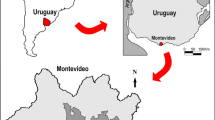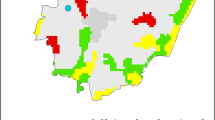Abstract
The concentrations of airborne fungal spores were measured during 2001–2002 in two sites in Poland—one in the city and the other in the countryside. The sites differed in habitat characteristics, such as urbanisation level, vegetation and microclimate. The aim of the study was to determine if, and in which way, land use type would affect spore occurrence. The volumetric method was used, and ten easily identifiable spore types were sampled and anyalysed: Alternaria, Botrytis, Cladosporium, Epiccocum, Ganoderma, Pithomyces, Polythrincium, Stemphylium, Torula and Drechslera. The season of spore occurrence was determined using the 90% method. The fungal spores studied were very frequent in the air (in most instances at a frequency higher than 50%). The most common spores were those of Cladosporium, with a frequency range of 83.1–90.5%. In both years the proportion of Cladosporium spores was statistically significantly higher in the city. In both 2001 and 2002 the total seasonal sum of all the spores was higher in the countryside than in the city as was the Seasonal Fungal Index (SFI) values and average concentrations of Botrytis, Ganoderma and Torula. These latter three genera are usually represented as pathogens of plants. The mean spore concentrations of most taxa were significantly higher in the rural environment. Correlation coefficients between daily concentrations at both sites for most of the taxa studied were significant, but with lower correlation values between variables. Such results indicate that the values from the sites are weakly interdependent. The study confirms that land use type may very likely have an impact on the course of spore occurrence, the mean daily concentrations of spores as well as SFI values.
Similar content being viewed by others
References
Adams, K. F. (1964). Year to year variation in the fungus spore content of the atmosphere. Acta Allergologica, 19, 11–50
Barnett, H. L. & Hunter, B. B. (1972). Illustrated genera of imperfect fungi. Minneapolis: Burgess
Burch, M., & Levetin, E. (2002). Effects of meteorological conditions on spore plumes. International Journal of Biometeorology, 46, 107–117
Calderon, C., Lacey, J., McCartney, A., & Rosas, I. (1997). Influence of urban climate upon distribution of airborne Deuteromycete spore concentrations in Mexico City. International Journal of Biometeorology, 40, 71–80
Corden, J. M., Millington, W. M., & Mullins, J. (2003). Long-term trends and regional variation in the aeroallergen Alternaria in Cardiff and Derby UK – are differences in climate and cereal production having an effect? Aerobiologia, 19, 191–199
Crook, B. (1994). Aerobiological investigation of occupational respiratory allergy in agriculture in the U.K. Grana, 33, 81–84
D’Amato, G., & Spieksma, F. Th. M. (1995). Aerobiologic and clinical aspects of mould allergy in Europe. Allergy, 50, 870–877
De Nuntiis, P., Bitelli, L., Guaraldi, C., Mandrioli, P., Salvi, A., Toschi, R., & Vitali C. (2003). Intermuseum network for conservation of the artistic heritage: MUSA PROJECT. In: Third European Symposium on Aerobiology. Worcester, UK, p. 16
Diaz, M. R., Iglesias, I., & Jato, M. V. (1997). Airborne concentrations of Botrytis, Uncinula and Plasmopara spores in a vineyard in Leiro-Ourense (N.W. Spain). Aerobiologia, 13, 31–35
Diaz, M. R., Iglesias, I., & Jato, V. (1998). Seasonal variation of airborne fungal spore concentrations in a vineyard of North-West Spain. Aerobiologia, 14, 221–227
Frenguelli, G. (1998). The contribution of aerobiology to agriculture. Aerobiologia, 14, 95–100
Grant Smith, E. G. (1990). Sampling and identifying allergenic pollen and molds. An illustrated identification manual for air samplers. San Antonio, Texas: Blewstone Press
Gravesen, S. (1979). Fungi as a cause of allergic disease. Allergy, 34, 135–154
GUS (2001). Ochrona Środowiska, Warszawa
Hasnain, S. M., (1993). Influence of meteorological factors on the air spora. Grana, 32, 184–188
Hirst, J. M. (1991). Aerobiology in plant pathology. Grana, 30, 25–29
Icenhour, C. R., & Levetin, E. (1997). Penicilium and Aspergillus species in the habitats of allergy patients in the Tulsa, Oklahoma area. Aerobiologia, 13, 161–166
Kasprzyk, I., Rzepowska, B., & Wasylów, M. (2004). Fungal spores in the atmosphere of Rzeszów (South-East Poland). Annals of Agricultural and Environmental Medicine, 11, 285–289
McCartney, H. A. (1994). Dispersal of spores and pollen from crops. Grana, 33, 76–80
Mitakakis, T. Z., & Guest, D. I. (2001). A fungal spore calendar for the atmosphere of Melbourne, Australia, for the year 1993. Aerobiologia, 17, 171–176
Myszkowska, D., Stępalska, D., Obtułowicz, K., & Porębski, G. (2002). The relationship between airborne pollen and fungal spore concentrations and seasonal pollen allergy symptoms in Cracow in 1997–1999. Aerobiologia, 18, 153–161
Nikkels, A. H., Terstegge, P., & Spieksma, F. Th. M. (1996). Ten types of microscopically identifiable airborne fungal spores at Leiden, The Netherlands. Aerobiologia, 12, 107–112
Nilsson, S., & Persson, S. (1981). Tree pollen spectra in the Stockholm region (Sweden), 1973–1980. Grana, 20, 179–182
Simeray, J., Chaumont, J. -P., & Leger, D. (1993). Seasonal variations in the airborne fungal spore population of the East of France (Franche-Comte). Comparison between urban and rural environment during two years. Aerobiologia, 9, 201–206
Stępalska, D., & Wołek, J. (2005). Variation in fungal spore concentrations of selected taxa associated to weather conditions in Cracow, Poland, in 1997. Aerobiologia, 21, 43–52
Trigo, M., Toro, F. J., Recio, M., & Cabeduzo, B. (2000). A statistical approach to comparing the results from different aerobiological stations. Grana, 39, 252–258
Unger, J. (1999). Comparison of urban and rural bioclimatological conditions in the case of a Central-European city. International Journal of Biometeorology, 43, 139–144
Wołek, J. (1992). Vademecum statystyki dla biologów. Polish Botanical Studies No.6. Polish Academy of cience, Cracow, p. 118
Acknowledgements
I would like to thank Professor Kazimierz Szczepanek and Dr. Danuta Stępalska, Institute of Botany, Jagiellonian University, Cracow, for their valuable comments on the manuscript. The research was financially supported by KBN grant nr. 6 PO468720.
Author information
Authors and Affiliations
Corresponding author
Rights and permissions
About this article
Cite this article
Kasprzyk, I., Worek, M. Airborne fungal spores in urban and rural environments in Poland. Aerobiologia 22, 169–176 (2006). https://doi.org/10.1007/s10453-006-9029-8
Received:
Accepted:
Published:
Issue Date:
DOI: https://doi.org/10.1007/s10453-006-9029-8




